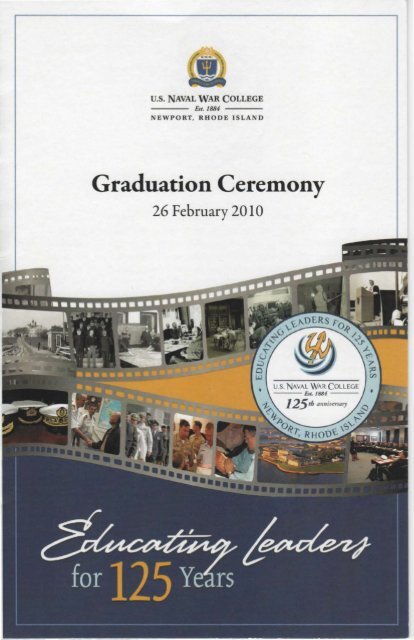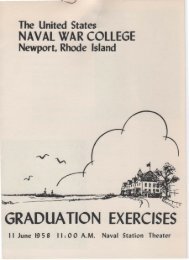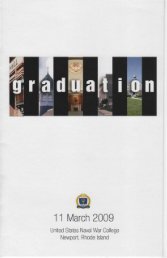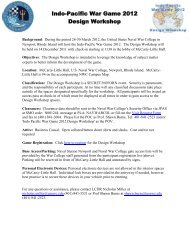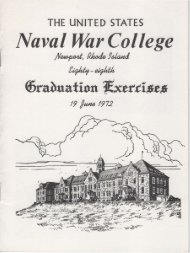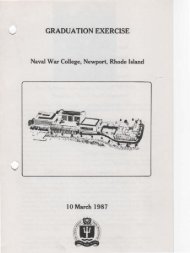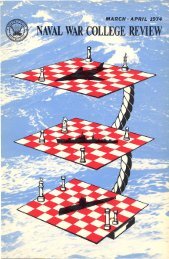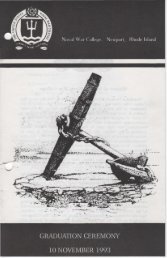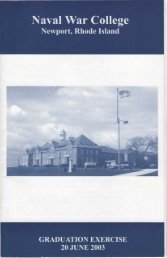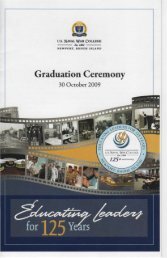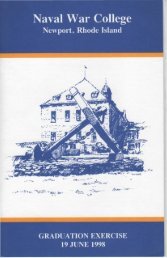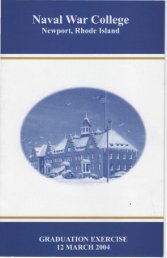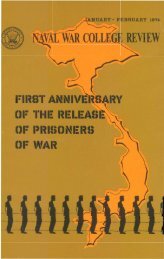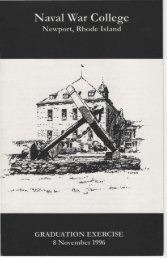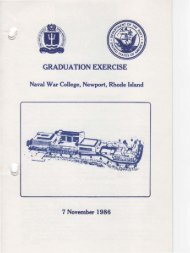February 26, 2010 - US Naval War College
February 26, 2010 - US Naval War College
February 26, 2010 - US Naval War College
You also want an ePaper? Increase the reach of your titles
YUMPU automatically turns print PDFs into web optimized ePapers that Google loves.
U.S. NAVAL WAR COLLEGE<br />
--- EsL /884 --<br />
NEWPORT, RHODE ISLAND<br />
Graduation Ceremony<br />
<strong>26</strong> <strong>February</strong> <strong>2010</strong>
HISTORY OF THE U.S. NAVAL WAR COLLEGE<br />
Founded in Newport, Rhode Island, on October 6, 1884, the <strong>Naval</strong> <strong>War</strong><br />
<strong>College</strong> is the oldest war college in the nation, and the first military service<br />
institution in the world to be designated a war college. Commodore<br />
Stephen B. Luce was the first president and organized the <strong>War</strong> <strong>College</strong> as<br />
"a place of original research on all questions relating to war and the<br />
statesmanship connected with war, or the prevention of war." These<br />
foundations were built upon by Captain Alfred Thayer Mahan, second<br />
president of the <strong>College</strong>, who had originally been selected by Luce to<br />
initiate the course in <strong>Naval</strong> History. Of all the men who were to influence<br />
the institution in its early years, none was to have a more profound impact.<br />
Mahan's views deeply affected such leaders as Henry Cabot Lodge and<br />
Theodore Roosevelt and through them and others helped shape the<br />
United States' destiny at the turn of the century. Mahan's writings,<br />
published as The Influence of Seapower Upon History, 1660-1783, gained<br />
him worldwide acclaim and established the <strong>Naval</strong> <strong>War</strong> <strong>College</strong> as an<br />
internationally respected institution.<br />
Functioning continuously since 1884, except for brief periods during<br />
the Spanish-American <strong>War</strong> and World <strong>War</strong> I, the <strong>War</strong> <strong>College</strong> numbers<br />
among its graduates such distinguished naval officers as Admirals Sims,<br />
Spruance, King, Nimitz, and Halsey, in addition to many others who today<br />
are holding prominent military positions.<br />
The work begun more than one hundred years ago by Luce and Mahan<br />
continues today. As graduates well know, the curriculum is both demanding<br />
and rewarding. For the military professional, the unique education provided<br />
by the <strong>Naval</strong> <strong>War</strong> <strong>College</strong> is unrivaled. In recognition of the academic<br />
rigor and educational excellence of its program, the <strong>Naval</strong> <strong>War</strong><br />
<strong>College</strong> was accredited in 1991 by the New England Association of Schools<br />
and <strong>College</strong>s to award a Master of Arts Degree in National Security and<br />
Strategic Studies.
THE ACADEMIC PROCESSION AND REGALIA<br />
For centuries, institutions of higher learning have dignified their<br />
ceremonies with an academic procession, a custom descending from the<br />
clerical procession. The procession is led by a marshal, followed by the<br />
student body and the academicians or faculty, attired in the robes prescribed<br />
for their respective degrees. Distinguished visitors and delegates follow the<br />
faculty, and last in the procession comes the president of the institution.<br />
Each member of an academic procession ordinarily wears a cap, gown,<br />
and hood. In the procession today military faculty will not wear academic<br />
gowns. The earliest illustration of gowns worn at Oxford University<br />
somewhat resembles cassocks worn by English teachers who found good use<br />
for the hood, or cowl, as protection against the weather. A uniform<br />
American system of academic heraldry displays the level of degree, the field<br />
of study in which it was earned, and the institution by which it was granted.<br />
It is the hood which provides academic regalia its color and offers the most<br />
infomlation about its wearer. The silk lining of the hood bears the color, or<br />
colors, of the degree-granting college or university; its velvet facing reveals the<br />
color assigned to each area of study. The Bachelor's gown is relatively sinlple,<br />
falling in straight lines from an elaborate yoke and having pointed sleeves. The<br />
Master's gown is slightly more elaborate and fastens about the wrist. The<br />
Doctor's gown is marked by velvet panels down the front and around the<br />
neck, as well as by three bars of the same material on the well-shaped sleeves.<br />
It is cut more fully and may be ornamented. The hood worn is three feet in<br />
length for Bachelors, three and one-half feet for Masters, and four feet for<br />
Doctorates, with velvet trimming of two, three, and five inches in width<br />
respectively.<br />
The edging, or facing, velvet of academic hoods indicates the area of study.<br />
The principal scholarly fields seen in the procession today include:<br />
Philosophy<br />
Arts, Letters, Humanities<br />
Business Adm in istratio Il<br />
Eco no m ics<br />
Engineerillg<br />
Law<br />
International Affairs/Public Administration<br />
Dark Blue<br />
White<br />
Light Brown<br />
Copper<br />
Orange<br />
Purple<br />
Peacock Blue<br />
The American mortarboard, derived from the soft Oxford cap, is black.<br />
Its tassel, for holders of the bachelor's and master's degree, is usually black,<br />
while gold ' tassels are worn by holders of doctoral degrees and heads of<br />
institutions. The tassel is worn on the right side of the cap by<br />
undergraduates, on the left by holders of bachelor's and higher degrees.
PROGRAM<br />
Master of Ceremonies<br />
Captain Sharon B. Campbell, U.S. Navy<br />
Dean of Students<br />
Procession of Students<br />
Arrival of Official Party"<br />
National Anthem"<br />
Sung by Mrs. Julie Zecher<br />
Invocation"<br />
Introduction<br />
Graduation Address<br />
Commander Neil J. Thompson, O.B.E., Royal Navy<br />
Professor, Joint Military Operations<br />
Presentation of Diplomas<br />
Charge to Graduates<br />
Rear Admiral James P. "Phil" Wisecup, U.S. Navy<br />
President, U.S. <strong>Naval</strong> <strong>War</strong> <strong>College</strong><br />
Benediction"<br />
"Guests please stand
Rear Admiral James P. "Phil" Wisecup<br />
President, U.S. <strong>Naval</strong> <strong>War</strong> <strong>College</strong><br />
Rear Admiral James 'Phil' Wisecup became the<br />
52nd president of the U.S. <strong>Naval</strong> <strong>War</strong> <strong>College</strong> on<br />
Nov. 6, 2008. He most recently served as commander,<br />
Carrier Strike Group 7 (Ronald Reagan<br />
Strike Group), returning from deployment in<br />
October 2008.<br />
A 1977 graduate of the U.S. <strong>Naval</strong> Academy,<br />
Wisecup earned his master's degree in international<br />
relations fro m the University of Southern<br />
California, graduated from the <strong>Naval</strong> <strong>War</strong> <strong>College</strong><br />
in 1998, and also earned a degree from the University of Strasbourg, France, as an<br />
Olmsted Scholar, in 1982.<br />
At sea, he served as executive officer of<strong>US</strong>S Valley Forge (CG 50) during Operation<br />
Desert Storlll. As commanding officer, <strong>US</strong>S Callaghan (DDG 994), he was<br />
awarded the Vice Admiral James Stockdale Award for Inspirational Leadership.<br />
He served as commander, Destroyer Squadron 21 during Operation Enduring<br />
Freedom after 9/11.<br />
Ashore, Wisecup was assigned to NATO Headquarters in Brussels, Belgium,<br />
served as force planner and ship scheduler for Commander, U.S. <strong>Naval</strong> Surface<br />
Forces, Pacific, and served as action officer for Navy Headquarters Plans/Policy<br />
Staff. He served as a fellow on the Chief of <strong>Naval</strong> Operations Strategic Studies<br />
Group; director, White House Situation Room and commander, U.S. <strong>Naval</strong><br />
Forces Korea.<br />
Wisecup's awards include the Defense Superior Service Medal, Legion of<br />
Merit, Bronze Star, and various unit, service and campaign awards.
Commander Neil J. Thompson, O.B.E.<br />
Royal Navy<br />
Professor, Joint Military Operations<br />
Educated at King's <strong>College</strong>, Taunton, Neil<br />
Thompson joined the Royal Navy in 1981. After<br />
flying training, he served in 845 <strong>Naval</strong> Air Squauron<br />
(NAS) at RNAS Yeovilton as a troop-carrying<br />
Wessex helicopter pilot, flying in Ascensioll IsI.lIlu<br />
and Europe before re-training onto the W.ISp<br />
helicopter, a ship-borne weapons carrier. Flight<br />
Commander of the Leander-class frigate H~IS<br />
Diolliede, he was the last operational Wasp pilot<br />
trained. In 1986-88, HMS Diolllede saw service in the North Atlantic, South Atlantic,<br />
and Arctic Oceans and the West Indies, Baltic and Mediterranean. He then<br />
converted to the Sea King before returning to 845 NAS as a Flight Commander<br />
and Instrument Rating Instructor in the commando assault role, before completing<br />
the Qualified Helicopter Instructor course in 1990. He then assumed the role<br />
of Commando Operational Flying Training Officer in 707 NAS. As Training Officer<br />
845 NAS, he deployed to United Nations operations in Bosnia during the<br />
civil war in 1993, where he was awarded the Queen's Commendation for Bravery<br />
in the Air (QCBA) for rescuing two Canadian soldiers from the besieged<br />
Srebrenica. As a Lieutenant Commander, Neil Thompson has served as the Senior<br />
Training Officer and Maritime Counter-Terrorism Flight Commander at<br />
848 NAS, where he was involved in UK counter-narcotics and hostage-rescue operations.<br />
As the Executive Officer of845 NAS, he carried out disaster relief operations<br />
in Honduras and Nicaragua in the wake of Hurricane MITCH in 1991\.<br />
Appointed to the newly-formed Joint Helicopter Command HQ at Wilton in<br />
2000, he was the amphibious aviation desk officer, before taking up the appointment<br />
as Commanding Officer 846 NAS in January 2003. Taking his squadron<br />
into southern Iraq in the wake of the invasion, his squadron saw 7 months of active<br />
duty in Basrah. He also commanded the Air Group ofHMS Oceal1 in 2004 for<br />
her exercises off North Carolina. Having handed over his squadron, he took COI11-<br />
mand of the UK's Joint Helicopter Force (Iraq) in 2005. In the last 3 years, he has<br />
served as the Chief Of Staff of the Commando Helicopter Force, before joining<br />
the <strong>Naval</strong> <strong>War</strong> <strong>College</strong> in Newport, Rhode Island as a student in 2007, graduating<br />
in June 2008. He was invested as an 'Officer of the Most Excellent Order of the<br />
British Empire' (OBE) for his outstanding leadership and selfless contribution to<br />
the nation's defense by HM the Queen in 2008. He is now a faculty member of the<br />
Joint Military Operations department. He is married to Becky and they live in<br />
Portsmouth, RI with their daughter, Phoebe (8), and their two dogs. Neil's interests<br />
include outdoor pursuits, old cars and history.
Ambassador Mary Ann Peters (ret.)<br />
Provost, U.S. <strong>Naval</strong> <strong>War</strong> <strong>College</strong><br />
Ambassador Peters became the fourth Provost<br />
of the <strong>Naval</strong> <strong>War</strong> <strong>College</strong> on 18 September 2008.<br />
Previously, she held the position of Dean of Academics<br />
of the <strong>College</strong> of International and Security<br />
Studies at the George C. Marshall EUJOpean<br />
Center for Security Studies in Garmisch<br />
Parten kirchen, Germany. Prior to becoming the<br />
Dean of the <strong>College</strong>, Ambassador Peters served as<br />
Associate Director for International Liaison at the<br />
Marshall Center.<br />
Before joining the Marshall Center in 2003, Ambassador Peters spent more<br />
than 30 years as a career diplomat with the U.S. Department of State. From 2000<br />
to 2003 Ambassador Peters served as the U.S. Ambassador to Bangladesh, leading<br />
the Mission's efforts in support of the war on terrorism and other key U.S. foreign<br />
policy goals. She received a Presidential Meritorious Service Award in 2003 for her<br />
work in Bangladesh. Prior to her posting in Dhaka, Ambassador Peters was the<br />
Deputy Chief of Mission at the United States Embassy in Ottawa, Canada, responsible<br />
for the management of the Embassy and supervision of the six U.S.<br />
Consulates General in Canada.<br />
From 1995 to 1997, Ambassador Peters served in the White House as Director<br />
for European and Canadian Affairs at the National Security Cow)cil. Among<br />
other portfolios in this position, Ambassador Peters worked on the diplomatic<br />
and security aspects of the search for peace in Northern Ireland. From 1993 to<br />
1994, Ambassador Peters served as Deputy Assistant Secretary of State with oversight<br />
responsibility for U.S. relations with 19 Western European countries and<br />
Canada. In this capacity she acted as the U.S. Chair of the U.S.-Canada military<br />
coordination body, the Permanent Joint Board on Defense.<br />
A senior diplomat, fluent in six foreign languages, Ambassador Peters has also<br />
served in Sofia, Bulgaria, as Deputy Chief of Mission; in Moscow as Economic<br />
Counselor; and in Mandalay, Burma, as Principal Officer. Prior to her assignment<br />
in Moscow, he studied Russian at the U.S. Army Russian Institute in Garmisch,<br />
Germany. From 1988 to 1990, Ambassador Peters was the Deputy Director of the<br />
Office of Pakistan, Afghanistan and Bangladesh Affairs in the U.S. State Department.<br />
She began her career as a Vice-Consul in Frankfurt in 1975.<br />
Ambassador Peters holds a Bachelor of Arts degree from Santa Clara University<br />
and a Masters in International Studies from the School of Advanced International<br />
Studies at The Johns Hopkins University. Her formal education also<br />
included course work in Paris, France, and Bologna, Italy.
Dr. John F. Garofano<br />
Dean of Academic Affairs<br />
John Garofano is Dean of Academic Aff.lirs,<br />
U.S. <strong>Naval</strong> <strong>War</strong> <strong>College</strong>, Newport, RI. Previousl)'<br />
he was Professor, Strategy and Policy Department,<br />
and Professor, National Security Decision<br />
Making Department, U.S. <strong>Naval</strong> <strong>War</strong> <strong>College</strong>. He<br />
received the Ph.D. in Government from Cornell<br />
University and an M.A. from the Johns Hopkins<br />
School of Advanced International Studies (Bologna!<br />
Washington).<br />
Dr. Garofano's research interests include military<br />
intervention, Asian security, and the making of U.S. foreign policy. His writings<br />
include The Intervention Debate: T01Vards a Posture of Principled Jlldglllt'llt<br />
(Carlisle, PA: 2002), Clinton's Foreign Policy: A Doculllentary Record (ed., Kluwer,<br />
2003), and articles in International Security, Asian Survey, COlltelllpomry SOlltheast<br />
Asia, Orbis and the <strong>Naval</strong> <strong>War</strong> <strong>College</strong> Review, among other journals.<br />
Prior to joining the <strong>War</strong> <strong>College</strong>'s faculty, Dr. Garofano has been a Senior Fellow<br />
at the Kennedy School of Government and a Professor at the U.S. Army <strong>War</strong><br />
<strong>College</strong>, the Five <strong>College</strong>s of Western Massachusetts, and the University of Southern<br />
California. Currently, he holds the Jerome Levy Chair of Economic Geography<br />
a11d National Security, and is an Area of Study Coordinator for Asia-Pacific<br />
electives.
COLLEGE OF NAVAL WARFARE<br />
Commander Jonathan Q. Adams, U.S. Navy<br />
Lieutenant Commander Raymond J. Albarado, U.S. Navy<br />
Lieutenant Commander Shawn T. Bailey, U.S. Navy<br />
Commander Kevin L. Barrett, U.S. Navy<br />
Lieutenant Commander Christian E. Cook, U.S. Navy<br />
Commander Robin AY Dahlin, U.S. Navy<br />
Commander David W. Dry, U.S. Navy<br />
Commander Jeffrey N. Farah, U.S. Navy<br />
Commander Tommy L. Fifer, U.S. Navy<br />
Commander Douglas W. Fletcher, U.S. Navy<br />
Commander Jenniffer D. Gundayao, U.S. Navy<br />
Captain William P. Hayes, U.S. Navy<br />
Colonel Karsten S. Heckl, U.S. Marine Corps<br />
M r. Timothy J. Krein, Office of Director of National Intelligence<br />
Lieutenant Commander Gregory J. Leland, U.S. Navy<br />
Commander Glen S. Leverette, U.S. Navy<br />
Lieutenant Commander Frederick R. Lickfold, U.S. Navy<br />
Commander Luis A. Maldonado, U.S. Navy<br />
Commander Michael L. Marlowe, U.S. Navy<br />
Commander Marvin B. McBride III, U.S. Navy<br />
Commander Matthew A. Miller, U.S. Navy<br />
Captain Scott A. Minium, U.S. Navy<br />
Commander Christopher T. Monroe, U.S. Navy<br />
Commander Darren W. Nelson, U.S. Navy<br />
Commander Carl P. Nolte, U.S. Navy<br />
Commander Antonio Oropeza, U.S. Navy<br />
~lr. Carlos A. Perez, Defense Leadership and Management Program<br />
Lieutenant Commander Wesley A. Price, U.S. Navy<br />
Lieutenant Commander Gregory G. Roberts, U.S. Navy<br />
Commander Matthew Paul Roberts, U.S. Navy<br />
COlllmander Christopher R. Schenck, U.S. Navy<br />
Lieutenant Commander Michael S. Seaton, U.S. Navy<br />
COlllmander Matthew T. Secrest, U.S. Navy<br />
Lieutenant Colonel William H. Seely, III, U.S. Marine Corps<br />
Commander Calvin D. Slocumb, U.S. Navy<br />
Comm,lI1der Charles C. Sparks II, U.S. Navy<br />
COl11mander Theodore J. St John, U.S. Navy<br />
Lieutenant Colonel James B. Stopa, U.S. Marine Corps<br />
COIllIll,lI1der Robert W. Stouse, U.S. Navy<br />
Co 111 111,lI1der Eric.: H. Venema, U.S. Navy<br />
Liellt('ll.Illt Commander Alvin S. Ventura, U.S. Navy<br />
Lil'lIll'n,lnt Coml11ander Glenn M. Zeigler, U.S. Navy<br />
COIllIll,lI1der John F. Zrembski, U.S. Navy
U.S. NAVAL WAR COLLEGE<br />
Esr. / 884 ---<br />
NEWPORT, RUODE ISLAND<br />
686 Cushing Road<br />
Newport, Rhodelsland 02841<br />
www.usnwc.edu<br />
Also search for us on Facebook and Twitter


